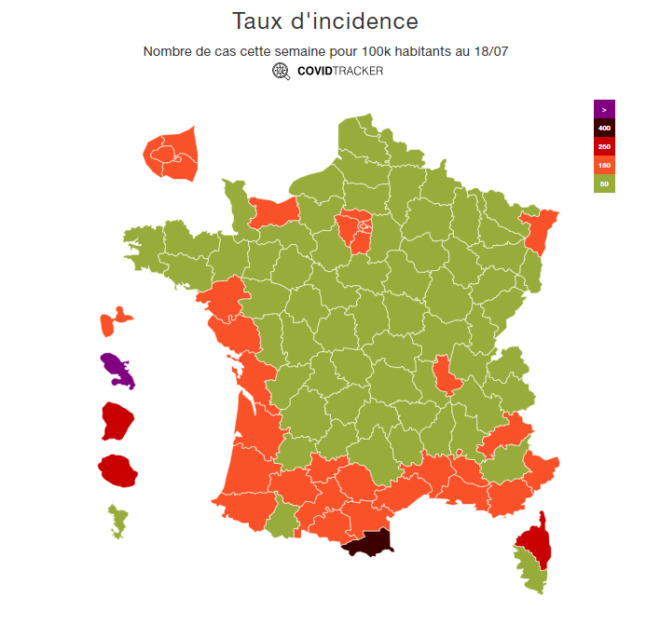In the 24 hours ending July 18th, 12,532 new cases of Covid-19 were confirmed, up from 10,949 on Saturday, July 17th; and 4,256 on Friday, July 16th.
The incidence rate (cases per 100,000 people) has risen above the alert threshold of 50 in 37 departments, notably along popular tourist areas – the southwest and Mediterranean coasts, and in Paris.

On July 12th, just 12 departments were recording an incidence rate of over 50. Nationally, the incidence rate is also increasing and stood at 63.5 on July 15th, compared to 32.2 on July 9th.
Cases are rising most rapidly in the Pyrénées-Orientales, where the latest Public Health France figures show an incidence rate of 299.6 cases per 100,000, followed by Haute-Corse (249.1), Alpes-Maritimes (133.6), and Charente-Maritime (109).
The rise in cases in coastal areas is not simply due to holidaymakers testing positive, since the incidence rate figures are based on a person’s department of residence, not where they took the Covid test.
READ ALSO: How high are vaccination rates where you live in France?
The spike in cases is linked to the spread of the highly contagious Delta variant of Covid-19, and has prompted local authorities to impose new restrictions.
Government spokesperson Gabriel Attal warned on Sunday that: “the Delta variant … is incredibly more contagious, more aggressive than the original strain of the virus”.
In an interview with Le Parisien, he said: “We have to be clear. Now, the options are either general vaccination or a viral tsunami. There is no alternative.”
In Pyrénées-Orientales, bars and restaurants are required to close at 11pm, and face masks are obligatory outdoors in public areas. These latest local rules are in place until at least August 2nd.
The Pas-de-Calais, Bas-Rhin and Var départements have also reinstated the obligation to wear a mask in busy outdoor areas such as markets and pedestrian streets.
Plans to extend the remit of the pass sanitaire – to include cinemas, theatres and museums as well as bars, cafés, restaurants, hospitals, nursing homes and for long-distance travel by coach and train – will be debated in the National Assembly on Wednesday.




 Please whitelist us to continue reading.
Please whitelist us to continue reading.
Good news! the quicker the unvaccinated make some antibodies the quicker it’s over!